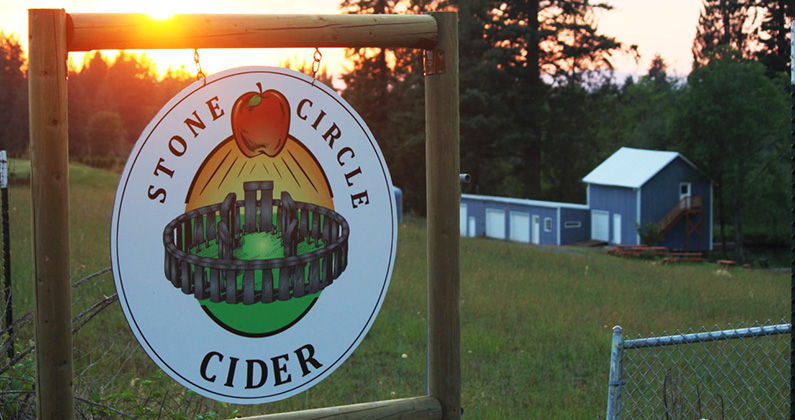The brains behind Stone Circle Cider — Sarah Hamblin; her husband, John Hamblin; and her brother Dan Lawrence — were well on their way to realizing their dreams when the trio ran headfirst into an obstacle that could have spelled doom for the nascent cidery: the laws of Stone Circle’s home state — Oregon.
Lawrence had spent six months learning the craft of making cider in England, and the trio had put together a business plan when they took the seemingly simple step of applying for a county land use permit in the fall of 2016. Lawrence knew that wineries could open tasting rooms on farms — and, given cider’s similarity to wine and Stone Circle’s location on a farm outside Estacada, Oregon — he figured it was a shoo-in.
Lawmakers disagreed. The law didn’t explicitly allow cideries to open on farmland. A land use process might have taken months and cost thousands of dollars, with no sure thing they’d receive approval in the end. But rather than let the law change their plans for opening a cidery, the trio opted for another approach — they aimed to change the law altogether.
Lawrence would eventually lobby in the state legislature and successfully lead an effort to change state law, but his route to the capitol started years earlier in the farms of England.
Learning to love cider
Lawrence grew to love cider when John Hamblin — a native of southwest Englander and Sarah’s husband — would bring the region’s farmhouse ciders to the United States for holiday visits. Lawrence recalls falling for the unfiltered, full-bodied ciders almost instantly. “It had a rich apple aroma and flavor to it,” he says. “I’d never had anything like it, and I fell in love with it.”
Fast forward a few years, and Lawrence teamed up with Sarah and John to buy an orchard just outside of Estacada, Oregon, where they would craft ciders unlike anything being made in the United States at the time. In learning to craft cider, the trio hoped to specialize in ciders using English- and French-style apples, which are higher in tannins (creating a subtle bitterness) and produce a cider with more body — an intentional choice, Lawrence says, that’s designed to connect visitors with cider’s roots.
As part of his own cider education, Lawrence lived with John’s family in England between August 2015 and February 2016 — peak cider pressing season — and spent that time crafting, serving and drinking as much cider as possible. “I got a really good feel for what makes the style the style,” he says.
Lobbying lawmakers in Salem
Lawrence returned to the United States in early 2016, and — months later — encountered an obstacle that threatened to derail Stone Circle before it could pour a single pint: Oregon state law didn’t allow for cider tasting rooms on areas zoned for farming or mixed farm and forest use.
Lawrence recalls pondering his next step while commiserating with a neighbor who eventually suggested he contact State Senator Alan Olsen, who represented Lawrence’s district.
Facing an otherwise time-consuming, expensive and uncertain land use application process, Lawrence reached out to the senator and pleaded his case: “Our argument was that, from a land use perspective, cider was exactly the same as wine — just with apples instead of grapes.”
Olsen introduced the bill, and Lawrence soon found himself in the state capitol in Salem, testifying in front of committees and lobbying individual lawmakers. “It was a little intimidating,” Lawrence says of talking up legislators. “The more nerve-wracking part of it was that I would be able to make a good case for what I was trying to accomplish — and that I wouldn’t be ignored.”
Stone Circle Cider (finally) opens its doors
Lawrence’s efforts paid off. Governor Kate Brown signed the bill into law in 2017, and Stone Circle Cider opened its tasting room doors over Memorial Day Weekend in 2019. The cozy tasting room includes a handful of tables and an L-shaped bar, with enough space for live music and views of an on-site pond. Patrons can enjoy drinking cider at a few outdoor picnic tables or next to an outdoor firepit, as well.
Later this summer, the trio will install what Lawrence calls a “cider museum” in the tasting room. The exhibit will include interpretive panels on how cider is made, the history of the drink, background on farming and more. And Lawrence says Stone Circle will soon invite local children to plant apple trees on the property, a program inspired by a field trip Lawrence took as a child, where he planted trees in a neighboring forest. “To this day, I can tell you where the tree I planted is,” he says.
Plans are also in the works to display the text of the bill that made it all possible. Because, as Lawrence sees it, Stone Circle is about sharing a love of cider — with family members over Christmas break, with taproom visitors on a sunny Saturday, and — yes — with lawmakers in session. “In an age of people always wanting to know what the new flavor of cider is, it can often get lost that cider is made from apples,” he says. “And having the ability to come to the farm and see what that process is and how it works will do a great deal to further consumers’ understanding of the industry.”






